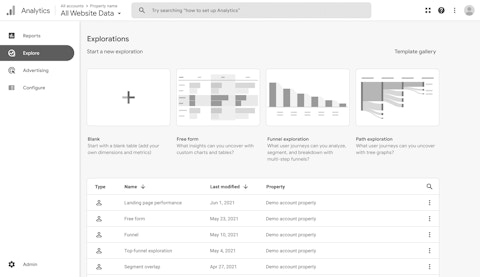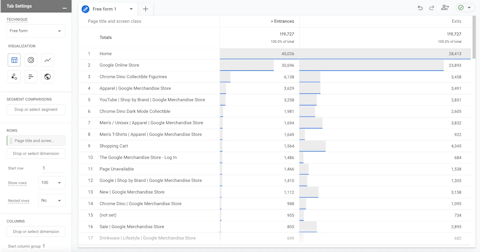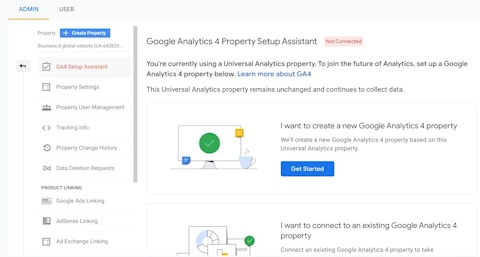Google Analytics is a staple in any marketer’s tech stack, but ever since Google Analytics 4 (GA4) went live, you might have noticed that your old approach just doesn’t work in the latest version. Not only is that frustrating, but it means you’re missing out on valuable data.
Building materials companies often cater to many different buyer personas, like architects, contractors and homeowners. That means your web traffic is a blend of many different prospects, each with different needs and goals.
Because of this, it’s critical that you’re able to effectively use tools like Google Analytics to track your site’s visitors and dig into the details that will help you better understand their journey, behavior and pain points.
For now, you can still opt to use Universal Analytics (the old interface) to manage your websites, but Google announced that GA4 will officially replace it in July 2023, at which point UA will stop collecting new data. Additionally, all historical data will be deleted from UA by December 2023, which means exporting your data from UA before then is crucial to maintaining key business insights.
So, while you still have some time, here’s a better look at why you should move to GA4 and some advice to make it easier.
What is Google Analytics 4?
When Google announced GA4 in October 2020, it represented the single most significant update to ever come to Google Analytics — and for good reason.
One major improvement that comes along with GA4 is a simplified, but more powerful, user interface. That means you’ll no longer have a cluttered dashboard of predefined reports.

When you log in to GA4, you’ll see visual summaries of all the key metrics in a neatly organized format. If you want to delve deeper, you can click on any metric to get more information.
GA4 also comes packed with new features and capabilities, like the ability to collect both website and app data; use predictive analytics; and directly integrate with other platforms (i.e., Google Ads and BigQuery) to drive user action.
All in all, GA4 is designed to be a futureproofed version of Google Analytics that’s here to stay for the foreseeable future. So, why the need for change?
Why The Shift?
Over the past few years, concerns over user privacy have led to new restrictions on what data your website can collect and how you can use it.
Earlier this year, most browsers phased out third-party cookies, making it more difficult to track a user’s journey. Because Google Analytics previously relied heavily on cookies, change was in order.
Not to fear — GA4 analytics use machine learning (ML) and statistical modeling to help fill the data gaps left by the absence of third-party cookies.
Thanks to its new model, GA4 analytics can better map events to a user’s journey, making it easier for you to understand and support your customers.
Meanwhile, better privacy controls like cookieless measurements will allow your business to stay ahead of regulations like GDPR and CCPA.
In addition to accommodating changing regulations, GA4 also created a clean slate to help Google implement new analysis technology in the years to come without needing additional code.
To sum it up, GA4 is designed to meet current needs, and it’s better positioned to accommodate all the requirements around the corner, too.
What’s New in GA4?
GA4 offers features not available in prior versions, and the redesigned user interface makes it easier than ever to make use of all that data.

First off, GA4 allows you to more effortlessly customize the dimensions and metrics displayed in your automated tables. Plus, you can save your own custom views so they show up every time.
Once you’re happy with how your data looks, you can start building upon it with GA4’s powerful predictive analytics, which is currently available for eCommerce companies. Among many things, GA4 will automatically start creating predictive audiences for you that utilize one or more predictive metrics.
For example, once you define purchase events, a predictive audience may be generated that shows ‘likely 7-day purchasers’ or ‘Predicted 28-day top spenders.’

The great thing about predictive audiences is that you can easily use them for advertising, re-marketing or re-engagement. These audiences will automatically populate within any Google Ads, Display & Video 360 or Search Ads 360 account you have linked to your property.
Plus, in addition to the predictive metrics that exist within the audience builder, you can also tap into them via the Explorations section. To make the most of it, we suggest increasing the default retention period from two months to 14 months (the maximum) to give you the most historical data to look at.
Excitingly, explorations in GA4 go beyond standard reports and allow you to use new features and fields.

While reports pull from daily aggregated tables, Explorations query raw event and user-level data directly. That’s why they’re great for quickly performing ad hoc queries, refactoring your data and creating new segments/audiences.
All of that, and there’s still a long list of powerful features that GA4 brings to the table. For most people, the only thing holding them back from making the switch is the sheer amount of familiarity they have with Universal Analytics, but don’t let that stop you.
What Are The Differences in Data Collection Between Universal Analytics & Google Analytics 4?
If you’re accustomed to using Universal Analytics, you’re going to have to step back and rethink how you approach your company’s data in order for GA4 to make sense.
In Universal Analytics, everything is built around sessions. However, with GA4 analytics, everything is built around users and events. This is a result of a completely redesigned data structure and data collection logic.

Because GA4 uses an events-based model, each user interaction represents a standalone event. Meanwhile, the session-based model used in Universal Analytics groups together all user interactions that happen within a given timeframe.
In practice, this difference means that GA4 makes it easier to map out the user journey and predict future behavior.
How Can GA4 Benefit Building Materials Companies?
As a building materials company, you’ll get the most out of GA4 if you focus on these highlights:
Real-Time Reporting
With GA4, you can instantly see the impact of your latest how-to video, expert demonstration or product launch by viewing the Real-Time Report in the left-hand navigation panel.
The Real-Time Report shows you all events that happened in the last 30 minutes. So, it’s a great thing to watch when you’re trying something new.
User Snapshots
Within the real-time report, the user snapshot feature allows you to dive into insights about individual visitors (device, location, etc.).
Looking at snapshots is a powerful way to learn more about your audience over time and finetune your buyer personas. For instance, you might be surprised to learn that most contractors visit your site on mobile.
Especially when combined with GA4’s other tools, user snapshots can reveal new trends and information, allowing you to stay on top of your audience’s changing preferences.
Life Cycle Reporting
You likely work with high-value customers, like architects, that have high acquisition costs. That’s why learning how users enter the conversion funnel and what events occur along the way is crucial.
Life Cycle reports reveal key insights on acquisition, engagement, conversion, and retention. As a result, you’ll have the information you need to optimize your marketing campaigns and make the most of your budget.
Explorations
Explorations, formerly known as the Analysis Hub, is one of the most unique and powerful tools introduced by GA4, allowing you to dive into a detailed analysis of your audience.
Using custom segments, dimensions and metrics, you can create a report and then visualize it in multiple ways.
The path analysis is one of the best, allowing you to discover looping patterns that could indicate a sticking point for your users that’s standing in the way of a purchase.
The Migration Process for GA4

The setup process will depend on how your existing Google Analytics tag is implemented on your website. You might use the Google Tag manager (a method we always recommend) or add the tag directly in the head section of your website.
To create your GA4 property, you will need to follow Google’s instructions and use Google’s Setup Assistant. We recommend this handy guide by Google on how to do that.
If you had custom events or conversions (goals) set up, you will need to migrate them to your GA4 property. The events in GA4 have an event name and multiple event parameters and values that you can define.
Google already has a list of recommended events. However, we always suggest configuring your custom data based on the exact needs of your business. So, now may be a good time to revise your data collection strategy and consider how this data can help you get better insights into your website and audience.
Why Should You Move from Universal Analytics to GA4 Now?
Change can be hard to swallow, especially if you’ve fallen into a routine with Universal Analytics. However, GA4 simply offers more powerful features and critical privacy controls that you aren’t going to be able to live without for much longer.
Because GA4 is forward-facing, historical data isn’t available. So, the sooner you make the switch, the more information you’ll have to work with when it comes to mapping out your user journeys and playing around with the new analysis tools.
Also, remember that UA will stop collecting data in July 2023 and all historical data will be deleted in December 2023. So, at some point, you’ll have no choice but to switch.
If you get GA4 setup now, you’ll have close to a full year of comparative data between the two, helping you to establish a baseline. This is extremely valuable given the significant changes in bot filtering and modeling between the two platforms.
With that said, there are plenty of reasons to embrace GA4, including:
Powerful predictive analytics, which is hard to find for free.
AI and ML capabilities far beyond what UA offers.
Custom reports that are much more comprehensive than UA dashboards.
Track up to 300 events, many of which don’t require code snippets.
Easily mark events as conversions and track up to 30 of them.
Clean data that filters out bots and crawlers, something that plagues UA.
The ability to disable cookies and advertising features for select countries.
Easy and streamlined controls for deleting user data.
Are you ready to start using GA4 yet? If you’re a bit overwhelmed by all that this new version has to offer, we can help! Contact us for more information on how we can help your company get the most out of its website analytics.








